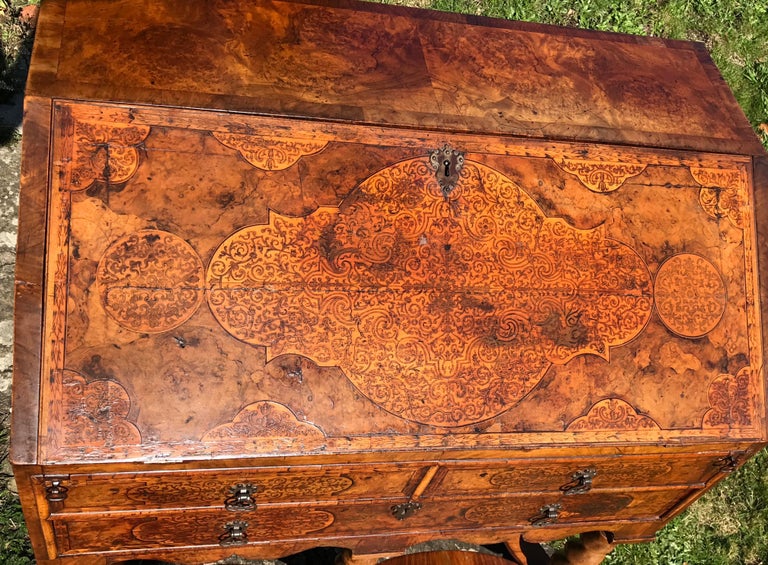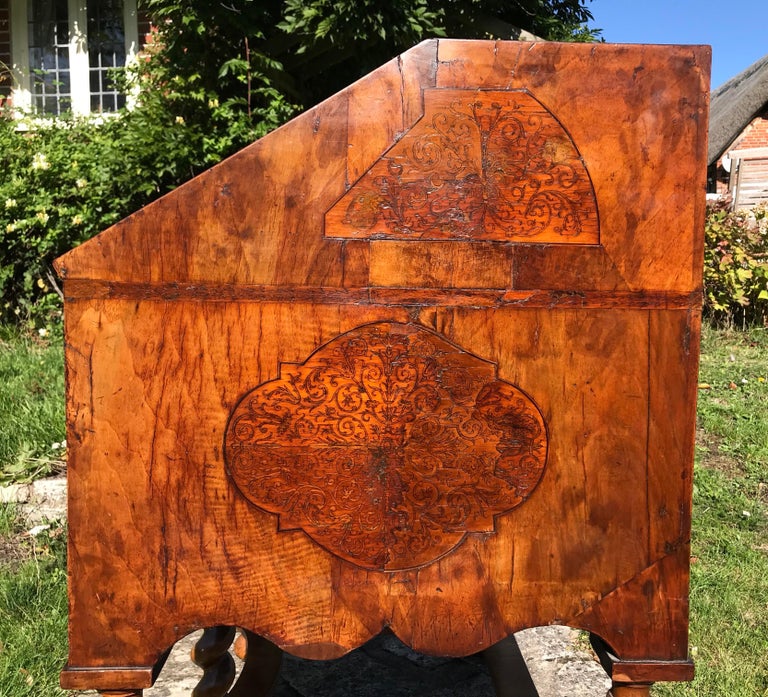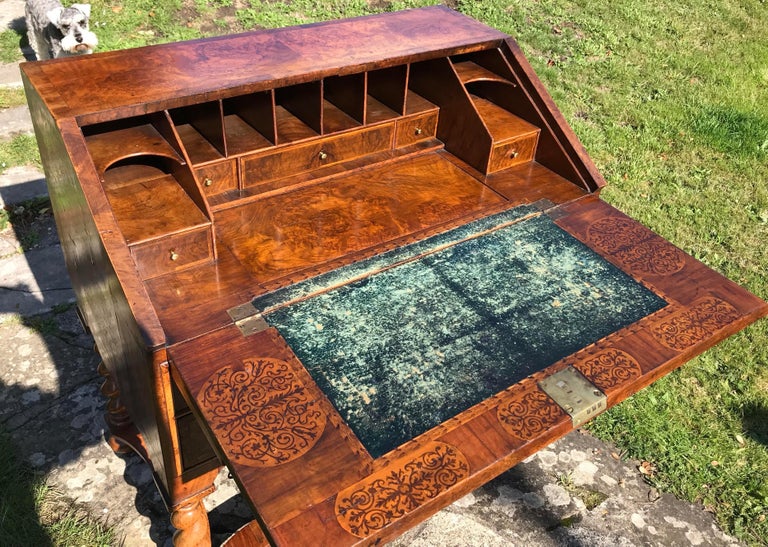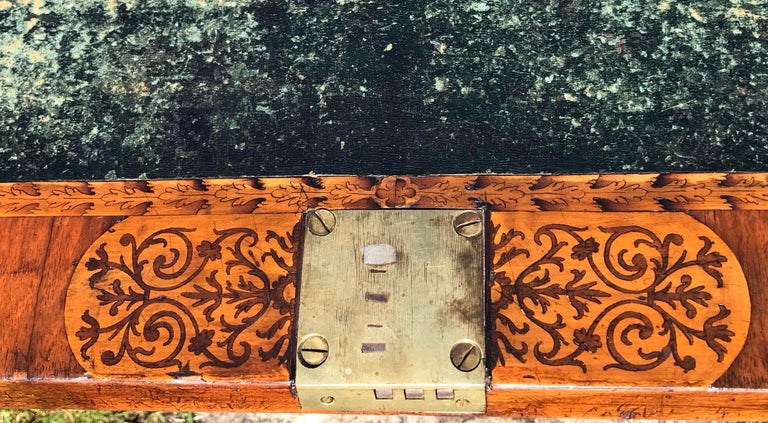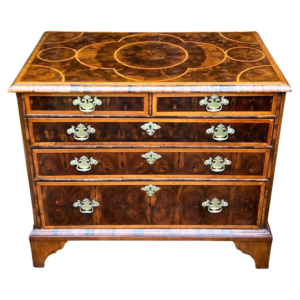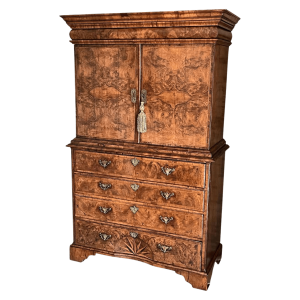Description
A burr walnut and marqueterie (or marquetry) bureau on stand, of lovely rich colour.
Late 17th century, William & Mary period, circa 1690.This small antique walnut and marquetry bureau is of a rare early form, a precursor to the transition taking place towards the end of the 17th century, away from chests and document boxes, to purpose-made furniture for the growing numbers of people learning to read and write. These early bureaux were often referred to in Old English as scriptors, écritoires, secretaries, skrewtores or scrutoires, and date from the William and Mary period (1689-1702).
Very few pieces made during this short transitional period survive, and almost none exist without some restoration especially to the vulnerable walnut stands. The walnut ‘barley sugar twist’ legs and stretcher have been replaced long ago.
It has a stepped, fitted interior and a concealed slide reveals a secret ‘well’.The burr walnut veneered top surface most probably would have shown some arabesque marqueterie inlay, lost over time. The sides and fall remarkably retain their original burr walnut veneers and complex inlays, all of lovely rich color and patina.
Hot sand-shaded foliate lines overall.Mounts period but not original. The lock to the fall however apparently is.
Majority of drawer linings are in walnut. The carcass is mostly in pine.
One could refer to this as a slant-front writing desk.A similar marquetry bureau on stand with later additions, re-veneering and later stand, sold at Christies, 14-15 April 2011, lot 379, for £6,640.00. From the collection of Milton Abbey, the Dorset home of the 1st Earl of Dorchester.
Refs:
‘The Shorter Dictionary of English Furniture’, Ralph Edwards CBE FSA (Hamlyn, London, Fourth impression 1972) p. 73, ills. 3 & 4, documents two almost identical examples with fine ‘seaweed’ or ‘arabesque marqueterie’ inlay panels, dated to 1690.
‘A History of English Furniture, Vol 1., The Age of Oak and Walnut’ by Percy Macquoid, p. 124, fig. 117 & m. 118 illustrates two closely related ”Walnut Inlaid Writing Tables”. Also a seaweed marquetry panel on p. 119, fig. 112.Further refs:
A pattern composed of oval and shaped reserves on a burr walnut ground filled with small-scale intricate scrollwork is often described as ‘Marquetrie a L’ Anglaise’. This ‘arabesque’ marquetry is generally ascribed to the talented Royal cabinet-maker Gerrit Jensen (see Adam Bowett, ‘English Furniture 1660- 1714’.) Vis also ‘From Charles ll to Queen Anne’ (Woodbridge, 2002) figs. 7:9-12, 7:20-21, 7:35, 7:39-40 and 7:48-49.At this time, during the reign of William and Mary, this costly and delicate marquetry inlay became highly fashionable amongst English Royalty and the wealthy nobility. It was produced by a few select émigré cabinet-makers who worked with marquetry in London, including the famous Jan van Mekeren, circa 1683.
Gerrit Jensen, a superb exponent of ‘arabesque marquetrie’, (active 1680-d.1715) was of Dutch or Flemish origin. He was known to be working in London from premises in St. Martin’s Lane by 1680, where he was known as a pre-eminent ‘Cabbinet maker and Glasse seller’. He was the only cabinet-maker working in England during this period known to have used metal inlays and elaborate ‘seaweed’ or ‘arabesque’ marquetry. His furniture reflects the fashionable French court styles of Pierre Golle, André Charles Boulle and Daniel Marot. The furniture was probably made for King William III and Queen Mary, by Jensen, who was appointed Royal cabinet-maker in 1689. Possibly first identified in Jensen’s invoice for the period of Michaelmas 1694 to Lady-Day 1695, which he supplied for William III’s service at Kensington Palace; ‘a Fine writeing desk table inlaid wth metall 70 pound.’
Cabinet, Jan van Mekeren (attributed to), c. 1695 – c …
collections.vam.ac.uk/item/O125660/table-unknownJensen, Gerrit (active 1680-d.1715) – Seaweed Writing Desk
https://www.rct.uk/collection/35317/seaweed-writing-deskJensen, Gerrit, ‘British and Irish Furniture Makers’
https://bifmo.history.ac.uk/entry/jensen-gerrit-1680-1715Laking, FR, & Laking, GF ‘The Furniture of Windsor Castle, London’ (1905).





